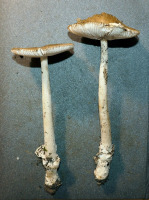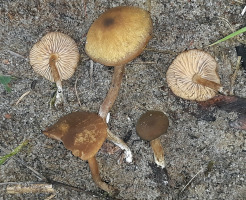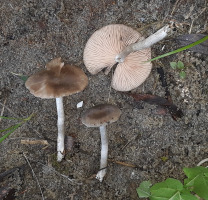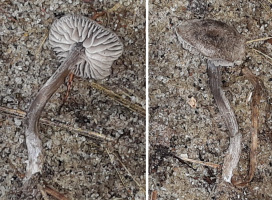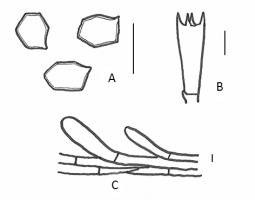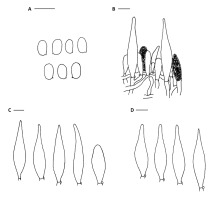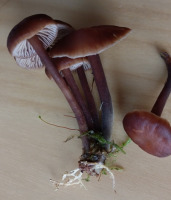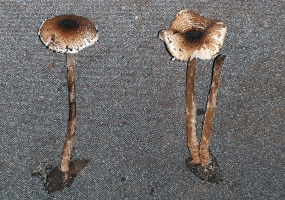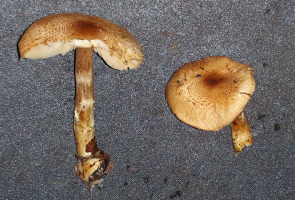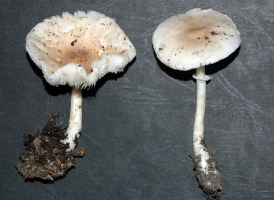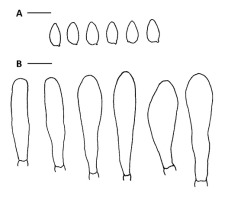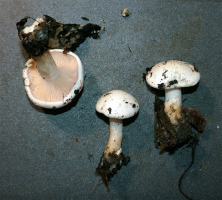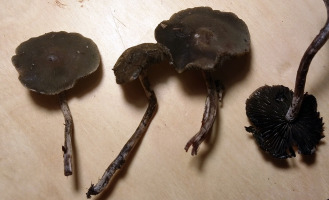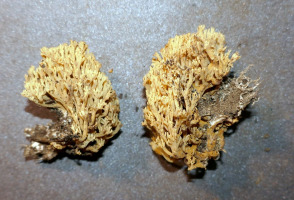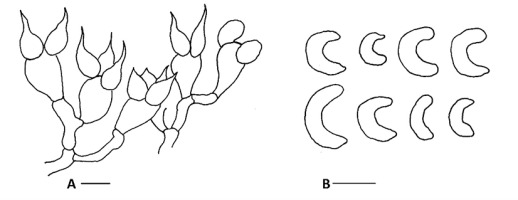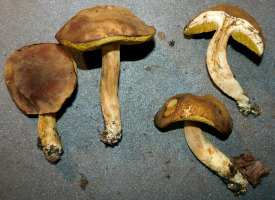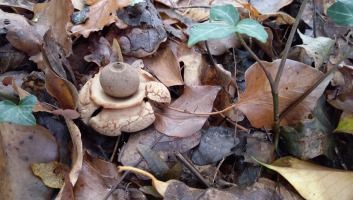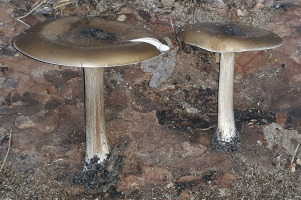Introduction
This article is a continuation of our previously published contribution to the mycobiota of Wielkopolski National Park (WPN), which is one of two national parks located within the borders of the Wielkopolska region. A general description of the study area and the history of mycological studies in WPN has been briefly described in the first part of this paper (Gierczyk & Kujawa, 2020). In 2018, the number of known species in this area was verified based on published and unpublished materials. At the close of the first year of this study, the number of fungal taxa in the WPN had reached 975. The taxa recorded in 2018 (312) included 140 that were new to WPN, 26 that were new to the Wielkopolska region, and five that had hitherto not been reported in Poland (Gierczyk & Kujawa, 2020). The purpose of this study was to present new mycological data for the WPN.
Material and Methods
Specimens were collected in 2019 from January to December using the route method. Forest compartment numbers are given after the Forest Data Bank (https://www.bdl.lasy.gov.pl/). Methods of specimen identification, taxonomic literature used, sources of nomenclature, distribution data, and threat/protection status in Poland have been previously described (Gierczyk & Kujawa, 2020). Additionally, the following monographs have been also used: Amanita (Galli, 2001; Kibby, 2012), Entoloma (Noordeloos, 1992, 2004), Inocybe (Ferrari, 2006, 2010; Ferrari et al., 2014; Kuyper, 1986; Stangl, 2011), Lactarius (Heilmann-Clausen et al., 1998), Mycena (Aronsen & Læssøe, 2016), Ramaria (Christan, 2008), Sowerbyella (Yao & Spooner, 2006), Tricholoma (Christensen & Heilmann-Clausen, 2013), Tulasnella (Roberts, 1994), Boletales (Mikšík, 2017), gasteroid fungi (Jeppson, 2013, 2018; Sarasini, 2005; Sunhede, 1989), and jelly fungi (Wojewoda, 1977). Dried specimens have been deposited in Błażej Gierczyk and Tomasz Ślusarczyk private fungaria, and in the fungarium of Turew Field Station of the Institute for Agricultural and Forest Environment of the Polish Academy of Sciences.
Results
During field research in WPN in 2019, over 1,250 records were collected, referring to 526 taxa (species, varieties, and forms). Among these, 189 had not previously collected within WPN. Nine taxa are new to Poland, and 24 to the Wielkopolska region. Many taxa have been confirmed for the first time in WPN almost 90 years since they were observed in the park. Among other interesting and valuable taxa, one could find, for example, species partially protected, observed only in single localities in Poland, or red-listed species (Ex – 1, E – 7, V – 8, R – 13, I – 1). Among the valuable species found growing in the WPN, many may have a higher chance of survival than their populations occurring outside protected areas. To the best of our knowledge, populations of numerous species are only preserved in the Wielkopolska region within the WPN [compare with other published data from this region, e.g., Gierczyk & Ślusarczyk (2020)]. The current state of knowledge indicates that some taxa need habitats and conditions for their growth and propagation that are secured only in protected areas, due to factors such as noninvasive forest management, presence of old tree stands, abundant coarse woody debris, or mosaic habitats (Moore et al., 2001). The current number of fungal taxa known in this park reached 1,122 (1,164 including species of uncertain status), which proves the importance of this area for protecting and conserving fungal biota in central Wielkopolska.
Abbreviations:
! – species new to Poland, # – species new to the Wielkopolska region;
LP – Landscape Park, NP – National Park, NR – Nature Reserve;
PU – Protection Unit (Polish: Obwód Ochronny): Jz – Jeziory; Gr – Górki; OG – Osowa Góra; Pu – Puszczykowo; Wi – Wiry; Wy – Wypalanki; in parentheses is given the number of forest compartment;
NICL – species not included in Polish checklists; PP – species partially protected by law; RL – species mentioned in Red List with categories: Ex – extinct, E – endangered, V – vulnerable, R – rare, I – indeterminate;
Ae – Aesculus hippocastanum, Al – Alnus spp., Al.g – Alnus glutinosa, Bt – Betula spp., Bt.p – B. pendula, Co – Corylus avellana, Cp – Carpinus betulus, Fg – Fagus sylvatica, Fx – Fraxinus excelsior, Pi – Pinus sylvestris, Pc – Picea abies, Po – Populus spp., Po.a – Populus alba, Q – Quercus spp., Rb – Robinia pseudoacacia, Sa – Salix spp.; Sy – Syringa spp., Um – Ulmus spp.
Annotated Species List: Ascomycota
Hypocrea sinuosa P. Chaverri & Samuels
!Phaeohelotium rufescens (Velen.) Declercq (Figure 1)
Specimens Examined
Wielkawieś, 1 km NNW (WyPU: 123K); IX/2019; nitrophilous vegetation on dirt road margin in a mixed forest; Pi cone.
Notes
Apothecia minute, disc- to cushion-shaped, sessile to subsessile, up to 3 mm in diameter, whitish, yellowish or dirty yellow, reddening after bruised. Asci without croziers, with amyloid apical apparatus. Spores ovoid or ellipsoid-ovoid, hyaline, smooth, without septa, 8–11 × 3.5–4.5 µm, with small guttules at both ends, oil content ca. 5% (OCI = 1–2). Paraphyses cylindrical, with strongly refractive content. Ectal excipulum of textura angularis.
Annotated Species List: Basidiomycota
!Acanthophysellum lividocoeruleum (P. Karst.) Parmasto (Figure 3)
Specimens Examined
Trzebaw, 1.2 km NNW (WyPU: 201); I/2019; mixed forest (Pi, Q, Fg, Cp, Um); branch of a deciduous tree.
Notes
Basidiomata thin, resupinate, smooth, grey with a distinct bluish tint. Basidia four-spored. Spores ellipsoid to subcylindrical, smooth, without iodine reaction, 6.5–8 × 3–4 µm. Acanthophyses indextrinoid, with short outgrowths in apical part. Cystidia obclavate to fusoid-ventricose, often with apical moniliform protuberance. Hyphal system monomitic. Clamps present.
Agaricus lutosus (F. H. Møller) F. H. Møller (Figure 4)
Specimens Examined
1. Wypalanki, 1.9 km SSW (WyPU: 171); IX/2019; Q forest; soil. 2. Ludwikowo, 0.5 km W (OGPU: 92); X/2019; broad-leaved forest; soil. 3. Wielkawieś, 0.6 km N (WyPU: 122K); IX/2019; mixed forest; soil. 4. Wielkawieś, 0.8 km NNW (WyPU: 123K); IX/2019; mixed forest (Q, Fg, Pi, Co); soil.
Agaricus moelleri Wasser (Figure 5)
!Agaricus moellerianus Bon (Figure 6)
Notes
Basidiomata stout, caps 8–13 cm in diameter, hemispherical, becoming plane with age, white with slightly ocher center, smooth or with scattered scales at a center. Stipe 6–9 × 1.5–2 cm, cylindrical, white to whitish, with small scales and fibrils. Annulus intermediate, thin, appressed. Context white, smell of bitter almonds. All parts of the basidiomata become yellow, then ocher-yellow, and finally brownish when rubbed or bruised. Basidia four-spored. Spores 6.5–7.5 × 5–5.5 µm, ellipsoid to (sub)ovate, smooth, dark brown, thick-walled, without germ pore but with thiner wall at apex. Cheilocystidia scarce (in some basidiomata absent), spheropedunculate, simple. Clamps absent.
#Amanita olivaceogrisea Kalamees; NICL (Figure 7)
Athelia alnicola (Bourdot & Galzin) Jülich
Specimens Examined
1. Górka, 1.5 km SSE (GrPU: 131); II/2019; alder forest margin; Al.g log. 2. Krosinko, 1.8 km N (OGPU: 149); II/2019; humid deciduous forest; Bt log. 3. Krosinko, 2.5 km N (OGPU: 144); II/2019; meadow margin; Pc log. 4. Trzebaw, 2 km NNW (WyPU: 199); I/2019; mixed forest; branch of a deciduous tree.
Bolbitius variicolor G. F. Atk.; NICL
!Callistosporium luteo-olivaceum (Berk. & M. A. Curtis) Singer (Figure 8, Figure 9)
Specimens Examined
1. Dymaczewo Stare, 1.7 km NNW (GrPU: 147); X/2019; oak forest; Q trunk. 2. Puszczykowo, 1.3 km NE (PuPU: 9); X/2019; deciduous forest; Pi log.
Notes
Basidiomata fasciculate, small, caps <3 cm in diameter, convex, campanulate to hemispherical, becoming applanate to concave with age, sometimes broadly umbonate, smooth, brownish to orange-brownish with olive hue, hygrophanous. Lamellae crowded, emarginate, dirty yellow, contrasting with pileus surface. Stipe central, cylindrical, pruinose at the top, otherwise fibrillose, yellowish-brown to brown with a darker base. Basidia four-spored. Spores smooth, thin-walled, ellipsoid, with pale yellowish to brownish content, without iodine reaction, 4.5–6.5 × 3.5–4.5 µm. Cystidia absent. Pileipellis a cutis composed of smooth or incrusted elements. Clamps present.
Collybia cookei (Bres.) J. D. Arnold
Specimens Examined
1. Dymaczewo Stare, 2 km N (GrPU: 139); X/2019; mixed forest; litter. 2. Rosnówko, 0.8 km NW (WyPU: 177); V/2019; mixed forest; decaying agaricoid fungi. 3. Mosina-Jeziory, 0.5 km W (JzPU: 121); hornbeam-oak forest; base of Q trunk. 4. Ludwikowo (OGPU: 92); X/2019; deciduous forest; litter.
#Conocybe subxerophytica Singer & Hauskn. var. brunnea; NICL
Cortinarius olearioides Rob. Henry; RL-V
Notes
From Wielkopolska NP C. fulmineus Fr. has been reported (Domański, 1955); however, this species is sometimes considered to be conspecific with C. olearioides.
Entoloma sericatum (Britzelm.) Sacc.; NICL (Figure 10)
!Entoloma terreum Esteve-Rav. & Noordel. (Figure 11, Figure 12)
Notes
Basidiomata solitary, small, caps <1 cm in diameter, convex to hemispherical, radially, coarsely fibrillose, blackish grey, hygrophanous, not translucently striate. Lamellae distant, adnexed, grey. Stipe central, cylindrical, longitudinally fibrillose, grey. Basidia four-spored. Spores five–six-angled, thick-walled, subisodiametrical, 8.0–9.0 × 6.5–7.5 µm. Cystidia absent. Pileipellis a cutis with transitions to the trichoderm composed of up to 11 µm wide, brown incrusted hyphae. Stipitipellis a cutis with many clavate terminal elements with smooth walls. Clamps only present in the hymenium.
!Flammulina populicola Redhead & R. H. Petersen (Figure 13)
Specimens Examined
Mosina, 0.5 km NW from the end of Jeziorna Street (OGPU: 91D); humid woodlot (Al.g, Po); deciduous wood.
Notes
Basidiomata small, caps 1–3 cm in diameter, convex, minutely pruinose, viscid, yellowish-orange with a darker center. Gills adnate, almost white. Stem cylindrical, cream color at the top, blackening towards a base, velutinous, rooting. Basidia four-spored. Spores hyaline, ellipsoid to ovoid, without iodine reaction, smooth, 6.5–8 × 4–5 µm. Cheilocystidia lageniform to clavate, pleurocystidia similar. Pileipellis an ixotrichoderm. Pileocystidia narrowly lageniform, somewhat thick-walled in the lower part, projecting. Clamps present.
Gymnopus erythropus (Pers.) Antonín, Halling & Noordel.
Specimens Examined
1. Wielkawieś, 1.4 km NW (WyPU: 125K); IX/2019; oak-hornbeam forest; litter. 2. Dymaczewo Stare, 2 km N (GrPU: 139); X/2019; broad-leaved forest; litter. 3. Mosina-Jeziory (JzPU: 121); X/2019; broad-leaved forest; litter. 4. Ludwikowo (OGPU: 92); X/2019; broad-leaved forest; trunk.
Gymnopus impudicus (Fr.) Antonín, Halling & Noordel. (Figure 14)
#Inocybe pseudodestricta Stangl & J. Veselský
Lepiota echinella Quél. & G. E. Bernard var. echinella; RL-E (Figure 15)
Specimens Examined
1. Wielkawieś, 0.6 km N (WyPU: 122K); IX/2019; broad-leaved forest; soil. 2. Wielkawieś, 1.9 km NW (WyPU: 126K); IX/2019; nitrophilous vegetation on the roadside; soil. 3. Wielkawieś, 0.6 km N (WyPU: 123K); IX/2019; nitrophilous vegetation on the roadside; soil. 4. Wypalanki, 1 km SSE (WyPU: 166); X/2019; nitrophilous vegetation on the roadside in a mixed forest; soil.
Lepiota ochraceofulva P. D. Orton (Figure 16)
!Leucoagaricus sublittoralis (Kühner ex Hora) Singer (Figure 17, Figure 18)
Notes
Basidiomata medium-size. Cap with broad umbo, first subglobose, then convex, hemispherical to applanate, finally concave, pale with a darker center, with pinkish-brown or pinkish-ochre colors, radially fibrillose at margins, up to 6 cm in diameter. Stipe cylindrical slightly inflated at a base, whitish with brownish hue in the lower part, indistinctly fibrillose, up to 15 cm high. Annulus ascending, white with a darker edge. Lamellae moderately distant, white, free. Basidia four-spored. Spores, 7–10.5 × 4–5.5 µm, amygdaliform, indistinctly apically papillate, hyaline, smooth, without germ pore, dextrinoid. Cheilocystidia cylindrical, narrowly clavate, narrowly utriform, or indistinctly lageniform. Pleurocystidia absent. Pileipellis a cutis of cylindrical, encrusted hyphae, often with fusoid terminal elements. Clamps absent.
Leucopaxillus rhodoleucus (Sacc.) Kühner; NICL (Figure 19)
!Marasmius anomalus Lasch var. microsporus (Maire) Antonín
Specimens Examined
Mosina, 0.5 km NW from the end of Jeziorna Street (OGPU: 91D); grassland on esker; dead grasses.
Notes
Variety differs from a typical one by spore dimensions, i.e., 13–16.5 × 3.5–5 µm (vs. 16–22 × 4–5 µm for var. anomalus) (Antonín & Noordeloos, 2010).
Panaeolus guttulatus Bres. (Figure 20)
#Pholiotina nemoralis (Harmaja) Bon var. dentatomarginata (Watling) Hauskn.
Ramaria decurrens (Pers.) R. H. Petersen; NICL (Figure 21)
#Sistotrema coroniferum (Höhn. & Litsch.) D. P. Rogers & H. S. Jacks.
#Tricholoma ustaloides Romagn.; NICL
!Tulasnella danica Hauerslev (Figure 22)
Xerocomus ferrugineus (Schaeff.) Alessio; NICL (Figure 23)
List of Taxa Reported from WPN Previously, Confirmed in 2019
Ascomycota
Ciboria amentacea (Balb.) Fuckel (149); Dialonectria episphaeria (Tode) Cooke (83); Hydropisphaera peziza (Tode) Dumort. (8); Hymenoscyphus albidus (Roberge ex Desm.) W. Phillips (171); H. fructigenus (Bull.) Fr. (126K); Hypoxylon fragiforme (Pers.) J. Kickx f. (177); H. howeanum Peck. (173); Nectria cinnabarina (Tode) Fr. (126K, 198); Orbilia xanthostigma (Fr.) Fr. (122K); Propolis farinosa (Pers.) Fr. (126K); Rhytisma acerinum (Pers.) Fr. (8, 10, 91B, 92); Rutstroemia firma (Pers.) P. Karst. (92, 122K); R. luteovirescens (Roberge ex Desmazières) W. L. White (92); Xylaria hypoxylon (L.) Grev. (8); X. polymorpha (Pers.) Grev. (8).
Basidiomycota
Agaricus bitorquis (Quél.) Sacc. (90, 217); A. campestris L. (155); A. impudicus (Rea) Pilát (8, 155); A. porphyrrhizon P. D. Orton (124K); A. semotus Fr. (166); A. xanthodermus Genev. (122K, 135); Agrocybe pediades (Fr.) Fayod (91D); A. praecox (Pers.) Fayod (166A, 182); Amanita citrina (Schaeff.) Pers. f. citrina (155); A. excelsa (Fr.) Bertill. f. excelsa (155); A. gemmata (Fr.) Bertill. (124K, 148); A. muscaria (L.) Hook. var. muscaria (121K, 122K, 126K, 155); A. phalloides (Vaill.) Link var. phalloides (124K, 141); A. porphyria Alb. & Schwein. (124K); A. rubescens (Pers.) Gray f. rubescens (124K); Ampulloclitocybe clavipes (Pers.) Redhead, Lutzoni, Moncalvo & Vilgalys (134, 160, 184); Antrodia xantha (Fr.) Ryvarden (83, 119); Armillaria borealis Marxm. & Korhonen (76); A. lutea Gillet (121, 155); A. ostoyae (Romagn.) Herink (141); Athelia arachnoidea (Berk.) Jülich (198); A. epiphylla Pers. (199); Auricularia auricula-judae (Bull.) J. Schröt. (10, 91B, 121, 125K, 160); Auriscalpium vulgare Gray (8, 91A, 92, 123K, 125K, 133, 160, 172); Baeospora myosura (Fr.) Singer (9, 76, 92, 121); Bjerkandera adusta (Willd.) P. Karst. (121, 125K, 155, 166A, 177, near the hospital in Ludwikowo); Bolbitius titubans (Bull.) Fr. (86, 155); Boletus edulis Bull. (124K, 155); Botryobasidium isabellinum (Fr.) D. P. Rogers (9, 86, 90, 136); B. robustius Pouzar & Hol.-Jech. (144); B. subcoronatum (Höhn. & Litsch.) Donk (90); Bovista aestivalis (Bonord.) Demoulin (122K); B. nigrescens Pers. (122K); Bulbillomyces farinosus (Bres.) Jülich (149); Byssomerulius corium (Pers.) Parmasto (160); Calocera cornea (Batsch) Fr. (92, 172, 208); C. furcata (Fr.) Fr. (125K); C. viscosa (Pers.) Fr. (132, 172); Chlorophyllum olivieri (Barla) Velling (10, 91A, 92, 123K, 147, 160, 167, 168, 172, 174, 176, 179, 184, 186); C. rachodes (Vittad.) Vellinga (124K, 125K, 135); Chondrostereum purpureum (Pers.) Pouzar (91A, 135, 208); Chroogomphus rutilus (Schaeff.) O. K. Mill. var. rutilus (125K, 134); Clitocybe agrestis Harmaja (5B, 166, Górka 1 km SW); C. candicans (Pers.) P. Kumm. var. candicans (135); C. fragrans (With.) P. Kumm. (8); C. metachroa (Fr.) P. Kumm. var. metachroa (147); C. nebularis (Batsch) P. Kumm. var. nebularis (8, 10, 91A, 91B, 122K, 123K, 135, 172); C. odora (Bull.) P. Kumm. var. odora (122K); C. phaeophthalma (Pers.) Kuyper (122K, 171); C. phyllophila (Pers.) P. Kumm. (155); Clitocybula platyphylla (Pers.) Malençon & Bertault (124K); Clitopilus hobsonii (Berk.) P. D. Orton (86, 91B, 92); C. prunulus (Scop.) P. Kumm. (90, 125K); Coniophora arida (Fr.) P. Karst. (78C, 190); C. puteana (Schum.) P. Karst. (91A); Conocybe juniana (Velen.) Hauskn. & Svrček var. juniana (155); C. rickeniana P. D. Orton (8, 121K, 133); C. siliginea (Fr.) Kühner (166h); C. tenera (Schaeff.) Fayod (122K, 139); Coprinellus disseminatus (Pers.) J. E. Lange (8, 91B, 155, 166A, 170, 208); C. domesticus (Bolton) Vilgalys, Hopple & Jacq. Johnson (122K); C. micaceus (Bull.) Vilgalys, Hopple & Jacq. Johnson (8, 9, 10, 92, 121, 122K, 123K, 166, 166A, 167, 175, 177); C. xanthothrix (Romagn.) Vilgalys, Hopple & Jacq. Johnson (123K, 172); Coprinopsis atramentaria (Bull.) Redhead, Vilgalys & Moncalvo (90, 91A, 122K, 155, 189A); C. lagopus (Fr.) Redhead, Vilgalys & Moncalvo var. lagopus (86); Coprinus comatus (O. F. Müll.) Pers. (85, 91D, 118B, 166, 167, 174, 182, 183, 189A, 210, 211, 216, 217, 223); Cortinarius largus Fr. s. lato (141); Crepidotus cesatii (Rabenh.) Sacc. var. sphaerosporus (Pat.) Ortega & Buendia (126K); C. variabilis (Pers.) P. Kumm. (91A, 92, 121, 122K, 136, 160, 172, 208); C. versutus (Peck) Sacc. (177); Crucibulum laeve (Huds.) Kambly (92, 123K, 125K, 133, 136, 167, 172, 180); Cyathus striatus (Huds.) Willd. (92, 121, 122K, 172); Cylindrobasidium laeve (Pers.) Chamuris (149, 199); Cystoderma amianthinum (Scop.) Fayod (134); Cystolepiota seminuda (Lasch) Bon (123K); Daedaleopsis confragosa (Bolton) J. Schröt. (8, 91A, 92, 125K, 172, 190A); Datronia mollis (Sommerf.) Donk (125K); Echinoderma aspera (Pers.) Bon (90, 92, 133); Entoloma araneosum (Quél.) M. M. Moser (123K); E. juncinum (Kühner & Romagn.) Noordel. (155); E. rhodopolium (Fr.) P. Kumm. f. rhodopolium (123K); E. sericeum Quél. var. sericeum (167); E. undatum (Fr.) M. M. Moser (125K); Exidia nigricans (With.) P. Roberts (89, 122K, 125K, 172, 173, 177, 184, 190A, 199); E. truncata Fr. (83, 88, 119, 166A); Fistulina hepatica (Schaeff.) With. (122K, 123K, 136); Flammulina velutipes (Curtis) P. Karst. var. velutipes (201); Fomes fomentarius (L.) Fr. (8, 9, 10, 78C, 86, 91A, 91B, 96, 122K, 123K, 136, 149, 160, 166A, 171, 174, 176, 179, 191B); Fomitopsis pinicola (Sw.) P. Karst. (8, 9, 10, 91B, 91C, 123K, 160, 179, 184, 186); Galerina clavata (Velen.) Kühner (5B); G. hypnorum (Schrank) Kühner s. Horak 2005 and de Haan & Walleyn 2006 (135); G. marginata (Batsch) Kühner s. lato (9, 76, 135, 171); G. triscopa (Fr.) Kühner (9, 167); Ganoderma lipsiense (Batsch) G. F. Atk. (8, 9, 10, 87, 95, 97, 121, 123K, 149d, 155, 175, 177, near the hospital in Ludwikowo); Geastrum fimbriatum Fr. (160); G. rufescens Pers. (122K); G. triplex Jungh. s. auct. (121, 122K, 123K; Figure 24); Gloeophyllum sepiarium (Wulfen) P. Karst. (9); G. trabeum (Pers.) Murrill (9); Gloeoporus dichrous (Fr.) Bres. (91A); Gymnopilus penetrans (Fr.) Murrill (9, 91B, 141, 160, 168, 175); G. picreus (Pers.) P. Karst. (135); Gymnopus brassicolens (Romagn.) Antonín & Noordel. (172); G. confluens (Pers.) Antonin, Halling & Noordel. (90, 122K, 123K, 123K, 155, 167, 172); G. dryophilus (Bull.) Murrill (90, 121, 122K, 123K, 125K, 167, 177, 184); G. fusipes (Bull.) Gray (122K, 147); G. peronatus (Bolt.) Gray (122K, 125K); Hapalopilus nidulans (Fr.) P. Karst. (123K, 136, 155); Hebeloma mesophaeum (Pers.) Quél. (8, 155); Hemipholiota populnea (Pers.) Bon (8); Hohenbuehelia mastrucata (Fr.) Singer (122K, 172); Hygrophoropsis aurantiaca (Wulfen) Maire (8, 9, 10, 122K, 135, 160, 172); Hymenochaete rubiginosa (Schrad.) Lév. (83, 93, 119, 125K, 166A, 172, 176); Hyphoderma nemorale K. H. Larss. (144); H. praetermissum (P. Karst.) J. Erikss. & Å. Strid (78C, 123K, 198); H. setigerum (Fr.) Donk (162, 190A, 198); Hyphodontia sambuci (Pers.) J. Erikss. (201); Hypholoma capnoides (Fr.) P. Kumm. (123K, 177); H. fasciculare (Huds.) Kumm. var. fasciculare (8, 9, 10, 76, 90, 91A, 91B, 91D, near 92, 123K, 123K, 125K, 155, 160, 171, 172, 177, 184, 186); H. lateritium (Schaeff.) P. Kumm. (125K, 160); Infundibulicybe catinus (Fr.) Harmaja (122K); I. gibba (Pers.) Harmaja (92, 125K, 147, 172); Inocybe asterospora Quél. (123K); I. cincinnata (Fr.) Quél. var. cincinnata; (5B); I. fuscidula Velen. var. fuscidula (8, 123K); I. hirtella Bres. (155); Inonotus radiatus (Sowerby) P. Karst. (91B, 155, 172); Ischnoderma benzoinum (Wahlenb.) P. Karst. (160, 208); I. resinosum (Schrad.) P. Karst. (172); Kuehneromyces mutabilis (Schaeff.) Singer & A. H. Sm. (106, 123K, 125K); Laccaria amethystea Cooke (122K); L. laccata (Scop.) Cooke (125K, 134); L. proxima (Boud.) Pat. (76); Lacrymaria lacrymabunda (Bull.) Pat. (8, 125K, 172); Lactarius deliciosus (L.) Gray (155); L. glyciosmus (Fr.) Fr; (134); L. necator (Bull.) Pers. (121K); L. obscuratus (Lasch) Fr. (122K, 125K); L. quietus (Fr.) Fr. (124K, 155); L. subdulcis (Bull.) Gray (123K); L. tabidus Fr. (91A, 121K, 122K, 126K, 135); L. torminosus (Schaeff.) Pers. (124K); Laetiporus sulphureus (Bull.) Murrill (90, 122K, 210); Langermannia gigantea (Batsch) Rostk. (91D); Leccinum scabrum (Bull.) Gray (166A); Lepiota clypeolaria (Bull.) P. Kumm. (122K, 123K); L. cristata (Bolton) P. Kumm. (8, 121K, 122K, 126K, 133, 166, 167, 171, 172); L. subincarnata J. E. Lange (8, 121K, 123K, 160, 166); Lepista flaccida (Sowerby) Pat. (8, 91A, 92, 121, 121K, 123K, 155, 172, 176); L. gilva (Pers.) Pat. (122K); L. nuda (Bull.) Cooke (10, 91A, 92, 124K, 132); L. saeva (Fr.) P. D. Orton (155); L. sordida (Schumach.) Singer (121, 122Km); Leucoagaricus leucothites (Vittad.) Wasser var. leucothites (8B, 91D, 155, 166, 171, 211); Lycoperdon excipuliforme (Scop.) Pers. (125K, 147); L. perlatum Pers. (92, 122K, 123K, 132, 166, 171, 172); L. pyriforme Schaeff. (8, 91, 121, 122K, 123K, 172, 184); L. utriforme Bull. (Górka 1km SW); Lyophyllum decastes (Fr.) Singer var. decastes (133); Macrocystidia cucumis (Pers.) Joss. var. cucumis (123K, 133, 186); Macrolepiota konradii (Huijsman ex P. D. Orton) M. M. Moser (10, 76, 91A, 92, 155, 160, 167, 172); M. procera (Scop.) Singer (8, 9, 10, 91A, 122K, 123K, 155, 184); Macrotyphula filiformis (Bull.) Rauschert (92, 121, 122Kg, 169, 170, 172, 175, 176, 184); Marasmius bulliardii Quél. (122K, 172); M. epiphyllus (Pers.) Fr. (91A, 92, 121, 166, 167); M. oreades (Bolton) Fr. (122K, 124K, 155, 160); M. rotula (Scop.) Fr. (9, 121, 122K, 123K, 125K, 166, 172); M. setosus (Sowerby) Noordel. (125K); M. torquescens Quél. (121); Melanoleuca brevipes (Bull.) Pat. (92, 167); M. friesii (Bres.) Bon (91D, 92, 121, 124K); M. grammopodia (Bull.) Pat. (141; Figure 25); M. melaleuca (Per.) Murrill s. lato (5B); M. polioleuca (Fr.) Kühner & Maire f. polioleuca (123K); Melanophyllum haematospermum (Bull.) Kreisel (8, 122K, 123K); Meruliopsis taxicola (Pers.) Bondartsev (124K, 190, 198); Mycena acicula (Schaeff.) P. Kumm. (91B, 121, 122K, 123K, 125K, 166, 171, 172); M. aetites (Fr.) Quél. (134); M. citrinomarginata Gillet (9, near 92, 122K, 172); M. epipterygia (Scop.) Gray var. epipterygia (76); M. erubescens Höhn. (92); M. flavoalba (Fr.) Quél. (126K); M. galericulata (Scop.) Gray (8, 9, 10, 91B, 92, 121, 123K, 125K, 155, 160, 166A, 167, 172, 176, 183, 184, 199); M. galopus (Pers.) P. Kumm. var. galopus (91A, 92, 121, 134, 171, 172); M. haematopus (Pers.) P. Kumm. (91B, 121, 122K, 125K, 208); M. hiemalis (Osbeck) Quél. (12, 125K); M. inclinata (Fr.) Quél. (172); M. leptocephala (Pers.) Gillet (91A, 92); M. polygramma (Bull.) Gray f. polygramma (122K, 122K, 171); M. pseudocorticola Kühner (12, 92, 121); M. pura (Pers.) P. Kumm. f. pura (91A, near 92, 172); M. rosea (Bull.) Gramberg (92, 102, 121, 123K, 125K, 155, 166, 167, 168, 169, 170, 172, 174, 175, 176, 179, 182, 183, 184, 186); M. sanguinolenta (Alb. & Schwein.) P. Kumm. (90A, 92, 121, 123K, 172); M. speirea (Fr.) Gillet (12, 91B, 92); M. vitilis (Fr.) Quél. (123K, 126K, 160, 166, 167, 171, 172, 176, 183, 184); M. zephirus (Fr.) P. Kumm. (8, 9, 10, 91B, near 92, 100, 102, 103, 121, 123K, 125K, 155, 160, 166, 167, 169, 170, 171, 172, 173, 174, 175, 176, 179, 182, 183, 184, 186); Mycetinis scorodonius (Fr.) Wilson & Desjardin (92, 121, 171); Naucoria bohemica Velen. (148); N. scolecina (Fr.) Quél. (125K); N. subconspersa Kühner (91D); Onnia triquetra (Pers.) Imazeki (76, 155); Ossicaulis lignatilis (Pers.) Redhead & Ginns (121, 146); Panaeolus papilionaceus (Bull.) Quél. var. papilionaceus (166); Panellus stipticus (Bull.) P. Karst. (172); Parasola conopilea (Fr.) Örstadius & E. Larss. (122K); P. plicatilis (Curtis) Redhead, Vilgalys & Hopple (123K); Paxillus involutus (Batsch) Fr. s. lato (8, 91B, 121K, 125K, 155, 160); P. rubicundulus P. D. Orton s. str. (121K); P. rubicundulus P. D. Orton s. lato (91D); Peniophora quercina (Pers.) Cooke (83, 124K, 166A, 172, 199); Peniophorella pubera (Fr.) P. Karst. (78C, 198); Phaeolus schweinitzii (Fr.) Pat. (160, 172); Phallus impudicus L. var. impudicus (92, 122K); Phellinus ferruginosus (Schrad.) Pat. (125K, 166A, 199); P. igniarius (L.) Quél. s. lato (8, 155); P. robustus (83, 119, 124K, 125K, 177); Phlebia radiata Fr. (91A, 91B, 92); P. subochracea (Bres.) J. Erikss. & Ryvarden (103); P. tremellosa (Schrad.) Nakasone & Burds. (8, 9, 10, 92, 125K, 133); Phlebiopsis ravenelii (Cooke) Hjortstam (78C, 122K); Pholiota adiposa (Batsch) P. Kumm. s. str. (160); P. conissans (Fr.) M. M. Moser (91D, 155); P. lenta (Pers.) Singer (179); P. limonella (Peck) Sacc. (Ludwikowo – near parking place); P. squarrosa (Weigel) P. Kumm. (121K, 155); Pholiotina velata (Velen.) Hauskn. (122K); Piptoporus betulinus (Bull.) P. Karst. (8, 92, 123K, 135, 91A, 91B, 191B); Pleurotus ostreatus (Jacq.) P. Kumm. (121); P. pulmonarius (Fr.) Quél. (121, 172, 176, 184); Plicatura crispa (Pers.) Rea (91A, 92, 125K, 190A); Pluteus cervinus (Schaeff.) P. Kumm. f. cervinus (10, 92, 121, 123K, 155, 166A, 172, 175, 199); P. cinereofuscus J. E. Lange (91D, 123K, 155, 167); P. nanus (Pers.) P. Kumm. f. nanus (123K, 124K); P. phlebophorus (Ditmar) P. Kumm. (92); P. podospileus Saccardo f. minutissimus (Maire) Vellinga (92, 103); P. salicinus (Pers.) P. Kumm. (9, 123K); P. semibulbosus (Lasch) Quél. (121, 124K, 155); P. thomsonii (Berk. & Broome) Dennis (123K); Polyporus badius (Pers.) Schwein. (91D, 121, 122K, 123K, 171, 172); P. squamosus (Huds.) Fr. (91C, 123K, 217); P. tuberaster (Jacq. ex Pers.) Fr. (172, 177); P. varius (Pers.) Fr. (124K); Porodaedalea pini (Brot.) Murrill (83, 90, 119, 141, 166, 172, 190, 190A, 191); Porostereum spadiceum (Pers.) Hjortstam & Ryvarden (121); Postia stiptica (Pers.) Jülich (122K); P. tephroleuca (Fr.) Jülich (90); Psathyrella corrugis (Pers.) Konrad & Maubl. (91D, 121, 123K); P. fatua (Fr.) Konrad & Maubl. (123K, 126K, 179/183); P. marcescibilis (Britzelm.) Singer (91D, 122K); P. microrrhiza (Lasch) P. Kumm. (91D, 122K, 123K, 123K); P. noli-tangere (Fr.) A. Pearson & Dennis (123K); P. orbicularis (Romagn.) Kits van Wav. (122K); P. piluliformis (Bull.) P. D. Orton (122K, 171, 173, 179, 184); P. prona (Fr.) Gillet (5B, 91D); P. spadiceogrisea (Schaeff.) Maire (near the hospital in Ludwikowo, 179/183, 199); Radulomyces confluens (Chaillet) M. P. Christ. (90, 144, 201); Resupinatus trichotis (Pers.) Singer (121, 136, 171, 208); Rhodocollybia butyracea (Bull.) Lennox f. asema (Fr.) Antonín, Halling & Noordel (76, 91B, 135, 171, 172); R. butyracea (Bull.) Lennox f. butyracea (8, 9, 10, 122K, 123K, 167, 176, 184); R. maculata (Alb. & Schwein.) Singer var. maculata (135); R. prolixa (Hornem.) Antonín & Noordel. var. distorta (Fr.) Antonín, Halling & Noordel (136); Rhodocybe gemina (Paulet) Kuyper & Noordel. (122K, Ludwikowo – between the hospital and Kociołek Lake); Rickenella fibula (Bull.) Raithelh. (9, 76, 92, 121, 122K, 125K, 141, 160, 172, 208); Russula cyanoxantha (Schaeff.) Fr. (123K); R. depallens (Pers.) Fr. (155); R. fragilis (Pers.) Fr. (123K); R. grisea Fr. s. Gillet (155); R. integra (L.) Fr. s. Maire (133); R. nigricans (136); R. nitida (Pers.) Fr. (133); R. ochroleuca Pers. (124K, 134); R. pectinata Fr. (123K); R. risigallina (Batsch) Sacc. (124K); R. sanguinea (Bull.) Fr. (134); R. vesca Fr. (141); Schizophyllum commune Fr. (8, 121, 171, 190A); Scleroderma bovista Fr. (122K); S. citrinum Pers. (141); S. verrucosum (Bull.) Pers. (155); Serpula himantioides (Fr.) P. Karst. (91A); Simocybe centunculus (Fr.) Singer var. centunculus (171); S. haustellaris (Fr.) Watling (92, 172); S. reducta (Fr.) P. Karst. (123K); Skeletocutis nivea (Jungh.) Jean Keller (8, 125K); Sparassis crispa (Wulfen) Fr. (100, 160, 172, near the hospital in Ludwikowo); Sphaerobolus stellatus Tode (122K); Steccherinum bourdotii Saliba & A. David (92); S. ochraceum (Pers. ex J. F. Gmel.) Gray (125K, 172); Stereum gausapatum (Fr.) Fr. (121, 123K); S. hirsutum (Willd.) Pers. (91B, 92, 125K, 155, 166A, 172, 173, 190A); S. rugosum Pers. (124K, 173); S. sanguinolentum (Alb. & Schwein.) Fr. (144); S. subtomentosum Pouzar (91B, 121, 208); Strobilurus esculentus (Wulfen) Singer (132); S. tenacellus (Pers.) Singer (83, 166, 166A, 177, 191B); Stropharia cyanea (Bull.) Tuom. (91B, 92, 123K, 155); S. pseudocyanea (Desm.) Morgan var. pseudocyanea (123K); Suillus grevillei (Klotzsch) Singer var. grevillei (124K); Tapinella atrotomentosa (Batsch) Šutara (121K, 141); Trametes gibbosa (Pers.) Fr. (136); T. hirsuta (Wulfen) Pilát (121, 125K, 208); T. ochracea (Pers.) Gilb. & Ryvarden (184); T. pubescens (Schumach.) Pilát (198); T. versicolor (L.) Pilát (10, 91A, 91B, 125K, 155, 166, 208); Tremella mesenterica Retz. (92, 121, 124K, 166, 172); Trichaptum abietinum (Pers. ex J. F. Gmel.) Ryvarden (83, 91A, 135, 166, 172, 191B); Tricholoma fulvum (Bull.) Bigeard & H. Guill. (123K, 141); Tricholomopsis rutilans (Schaeff.) Singer (8, 208); Tubaria furfuracea (Pers.) Gillet s. lato (122K, 172, 200); Tulasnella violea (Quél.) Bourdot & Galzin (78C, 199); Typhula erythropus (Pers.) Fr. (92, 208); T. gyrans Batsch (121); Vuilleminia comedens (Nees) Maire (83); Xerocomus badius (Fr.) E.-J. Gilbert (76, 124K, 141); X. chrysentheron (Bull.) Quél. (125K, 155, 160); X. cisalpinus Simonini, H. Ladurner & Peintner (121, 121K, 123K); X. ripariellus Redeuilh (122K); Xerula pudens (Pers.) Singer (121); Xylodon nespori (Bres.) Hjortstam & Ryvarden (122K, 200); X. paradoxus (Schrad.) Chevall. (90, 122K).
Summary
During this second year of route-method field research in WPN (in 86 forest divisions), over 1,250 records of 526 taxa were collected, including 189 not hitherto mentioned from WPN. Among them, nine taxa are new to Poland (Acanthophysellum lividocoeruleum, Agaricus moellerianus, Callistosporium luteo-olivaceum, Entoloma terreum, Flammulina populicola, Leucoagaricus sublittoralis, Marasmius anomalus var. microsporus, Phaeohelotium rufescens, Tulasnella danica), and 24 are new to the Wielkopolska region (e.g., Buchwaldoboletus lignicola, Mycena diosma, Sistotrema coroniferum). One species protected by law (Geastrum corollinum) was recorded. In addition, numerous red-listed species new to WPN were found: Ex – 1 (Lepiota erminea), E – 7 (e.g., Bovista graveolens, Phlebia livida, Xerula melanotricha), V – 8 (e.g., Buchwaldoboletus lignicola, Limacella guttata, Tricholoma populinum), R – 13 (e.g., Botryobasidium laeve, Hymenochaete tabacina, and Russula caerulea), and I – 1 (Russula chloroides). These results indicate the necessity and legitimacy of further mycological studies in WPN. The current number of fungal taxa known in this park reached 1,122, which proves the importance of this area for protecting and conserving fungal biota in central Wielkopolska.
Handling Editor
Andrzej Szczepkowski; Warsaw University of Life Sciences – SGGW, Poland; https://orcid.org/0000-0002-9778-9567
Authors’ Contributions
BG: field research, specimen determination, photographic documentation, and manuscript preparation; AK: field research, specimen determination, photographic documentation, and manuscript correction; TŚ: field research, specimen determination, photographic documentation, and manuscript correction







